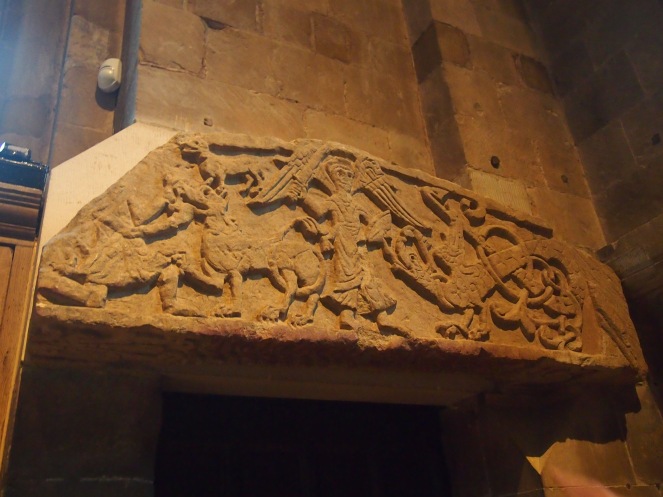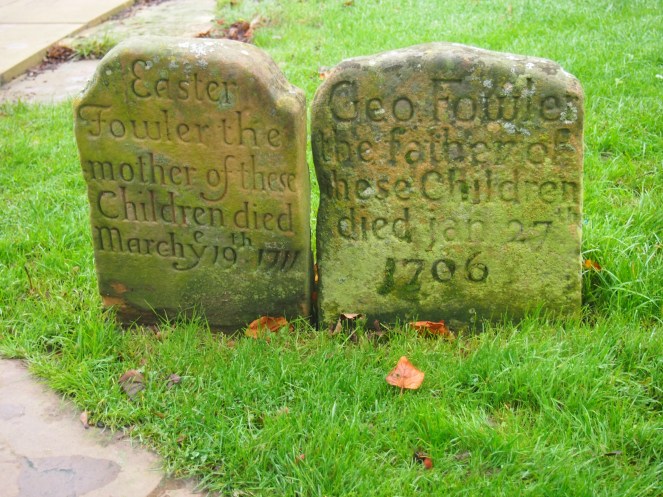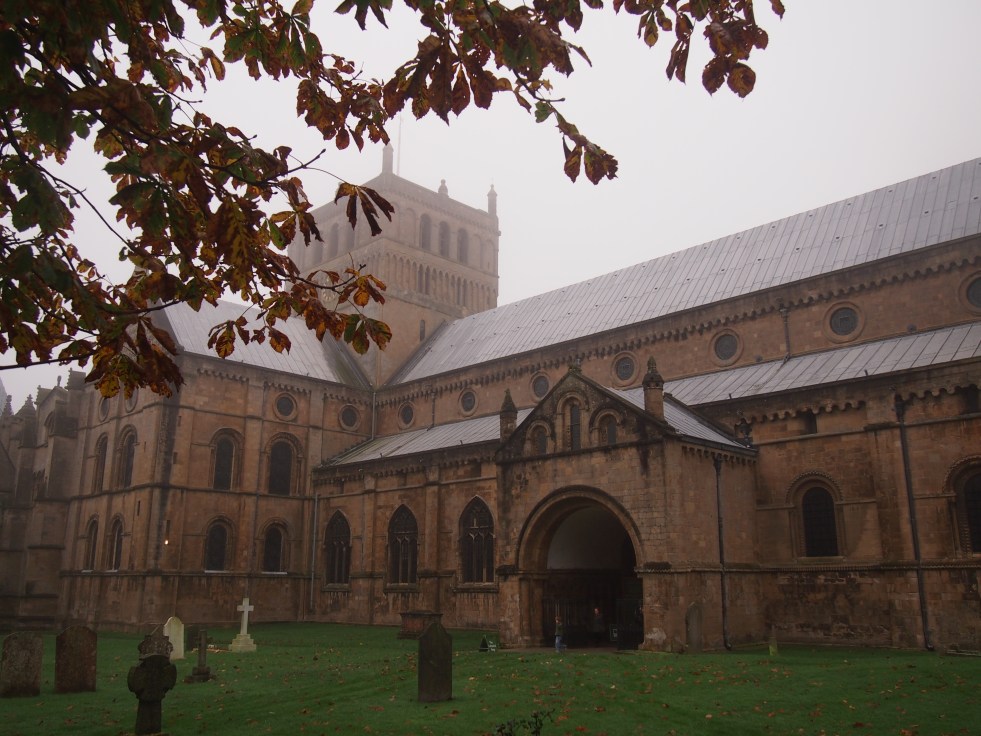A few weeks ago, I was spending the weekend with old friends in Sheffield, and on the Saturday afternoon we drove out to Southwell, a pretty little town in Nottinghamshire. I wasn’t sure what to expect – my friend had sold Southwell to me as a beautiful and interesting historic town, but I had no idea of the magnificent gem at the heart of Southwell – the Minster.

The distinctive “pepper pot” towers are Romanesque – or Norman – in design. However, the towers we see today were constructed in the late 19th Century, replacing the earlier towers which had been taken down in 1801 after they became unsafe. This wonderful website about the photography of Alfred John Loughton, who lived in Southwell, includes a view of the Minster before the pepperpot towers were rebuilt.

The grand Norman church began to be constructed in 1108, replacing a much smaller Saxon church on the same site. It’s possible that the earliest church on the site was founded in the early 7th Century, possibly by Paulinus, a missionary from Rome who became the first Archbishop of York. A Roman villa once stood on the site of the present minster – perhaps the materials from this structure were used to build the earlier churches on the site. Today, it’s possible to see part of the floor of the old Saxon church in the south transept of the minster. The church gained minster status in 956 – the term “minster” has had different meanings over time but at the time that the church at Southwell was given this title, it was used to describe a collegiate church – that is, a church served by a group of secular canons (as opposed those belonging to a religious order).
Today, the minster is also a cathedral – in 1884 the Diocese of Southwell and Nottingham was created, and the bishop’s seat is at Southwell Minster.

Southwell is perhaps best known as the place where King Charles I spent his last night of freedom in May 1646 before he surrendered to Parliamentary forces who were besieging nearby Newark. The Minster, like so many other churches and cathedrals in England, suffered a great deal during the Civil War. The nave was apparently used as a stable and Parliamentary soldiers defaced many of the intricately carved figures in the building. A 1796 history of Southwell describes how “soldiers were suffered to break down the monuments [in the minster], and ransack the graves of the dead for lead and other valuables.” The old Bishop’s Palace adjacent to the minster was also severely damaged by Civil War soldiers and, while its great hall is now part of a house, some of the ruins are still visible today.
One of the main victims of the Civil War-era vandalism was the pulpitum or quire screen between the nave and the quire, which dates from the early 14th Century and was built in the sumptuous Decorated Gothic style. Many of the carved faces and figures were smashed. Fortunately, a gifted sculptor restored the screen in the 19th Century.


The Civil War wasn’t the only cause of damage to the minster. In 1711, lightning struck one of the spires and the resulting fire destroyed the roof of the nave and the organ, and was ferocious enough to melt the minster’s bells. The minster was hastily repaired, but the work was not of a high quality and the shallower replacement roof of the nave once again had to be replaced in the late 19th Century, when the building underwent a significant and sympathetic restoration under the supervision of Ewan Christian.

The Norman quire of the church was replaced in the 13th Century by a new, larger quire in the Early English Gothic style. It was also in the 13th Century that work began on the minster’s beautiful chapter house. The chapter house is similar in design to the chapter house at York Minster, and is built in the Decorated Gothic style. The intricately carved leaves of the chapter house at Southwell are justifiably famous for their beauty. These incredible medieval carvings are richly detailed and as well as depicting leaves also feature green men and beasts both real and mythical. Fortunately much of the decoration in the chapter house survived the vandalism inflicted on the minster during the Civil War, and today the carving is world-reknowned as a stunning example of medieval craftsmanship.



Hidden away in the minster’s north transept is an extraordinary carved stone tympanum that is estimated to date from about the eleventh century. The winged figure of the Archangel Michael, in the centre of the carving, is depicted fighting off a dragon. This was a popular motif in the early Norman period, and symbolised the triumph of good over evil.

The imposing brass eagle lectern in the minster took an unconventional route to its current home in Southwell. Manufactured in 1503 in Tournai (now a part of Belgium), it was the property of Newstead Abbey in Nottinghamshire until its disillusion in the 1530s. When the abbey’s assets were about to be seized by Henry VIII’s men, the monks of Newstead Abbey hid the title deeds to their buildings and land in the globe the eagle is standing on, and then threw the whole lectern into a pond to prevent it from being looted. Newstead Abbey later became home of the Barons Byron, ancestors of the famous poet Lord Byron. During the 18th Century the old abbey duckpond was drained, which led to the discovery of the old lectern. It was while this extraordinary survivor was being restored that the title deeds of the old abbey were discovered inside the lectern’s globe. It was acquired for the minster in 1805 when it was sold at auction.

Some of the stained glass windows behind the altar also have a rather dramatic history. The four lower windows were not originally made for Southwell Minster, but instead came from the church of the notorious Temple fortress in Paris. This is where members of the French royal family, including Louis XVI and Marie Antoinette, were famously held during the French Revolution. Like the eagle lectern, they were manufactured in the 16th Century in mainland Europe – the windows, each depicting a scene from the life of Christ, were created by Jean Chastellian in 1528. After the Ancien Régime was overthrown and principal royals guillotined, the Temple became a place of pilgrimage for supporters of the French royal family, and to prevent this continuing Napoleon ordered that the entire Temple complex be demolished in 1808.
The fortress took two years to demolish, and during that time some of the windows from the church were rescued and preserved. The windows came to be in a junk shop in Paris, where they were discovered in 1818 and presented to Southwell Minster by Henry Gally Knight, a local squire and antiquarian.

The image below shows how extra glass was added to the top of the windows so that they would fit into the pointed window frames at Southwell Minster.
![Two of the beautiful stained glass windows resuced from [] chapel in Paris (image from Wikimedia Commons](https://flickeringlamps.com/wp-content/uploads/2014/11/southwell_minster_022.jpg?w=663&h=883)

The highlight of our visit to the minster was definitely meeting the wonderful verger – whose name we didn’t learn – who gave us over an hour of her time showing us around the church and pointing out many of the interesting features that I’ve written about here. Her knowledge and clear love for the minster added a huge amount of value to our visit and really brought the beautiful old building to life.

In the minster’s large churchyard gravestones from the 17th Century onwards survive. The oldest one I came across, from 1620, is unintentionally funny. Whoever W.T.F. was, I’m sure they had no idea that their gravestone would be eliciting giggles from passers-by four centuries after their death.


Many of the gravestones of Southwell Minster were cleared in the 1950s, but many of those that remain are of a high quality and have interesting designs.




Southwell Minster was such a pleasant surprise. Before visiting, I’d had no idea that this wonderful building even existed, and to be able to explore it and hear its stories made for a wonderful afternoon. It’s a beautiful medieval building and the stunning chapter house alone is worth making the trip to Southwell. I’m not sure that my gloomy photographs really do the place justice. The minster is open all year round, and entrance is free (although a photography permit will cost you a small amount).

References and further reading
Southwell Minster – Minster History http://www.southwellminster.org/minster-history-1.html
Southwell Minster – A History and Guide (booklet purchased from the Minster Book Shop)
Southwell Minster, information for visitors and details of its attractions for tourists – Eastern Cathedrals http://easterncathedrals.org.uk/members/southwell-minster.php
Southwell Minster – Interior photographs – Photography of A J Loughton http://www.ajloughton.co.uk/minster-interior.php
Southwell Minster – Exterior photographs – Photography of A J Loughton http://www.ajloughton.co.uk/minster-exterior.php


Wonderful building, on my list to visit 🙂
LikeLike
I definitely recommend a visit – there’s so much to see!
LikeLiked by 1 person
A splendid building, which you describe with such enjoyment and perhaps awe. A thoroughly enjoyable read. Thank you. And the photos are fine too.
LikeLike
Thank you! I’m glad that how much I enjoyed visiting Southwell came through in this post – when I visited, it really made my day to explore such a wonderful and interesting building.
LikeLike
It is a lovely building isn’t it? I suspect that it isn’t that well recognised because it is surrounded by a combination of unspectacular countryside and a former mining area, with few other tourist attractions in the area. I grew up in the latter and went to Southwell quite often. The lectern is really impressive but I was oddly terrified it as a child. I haven’t been for a few years and must revisit, thanks for the reminder. An excellent piece.
LikeLike
Thank you! I have a feeling that the minster would be much more well known if it was in a “touristy” city – but that’s what’s so fantastic about this country, there are some incredibly interesting and beautiful old places hidden away in the most unexpected places.
LikeLike
Fascinating piece, Caroline. That story about the Parisian windows is remarkable. Re the eagle lectern in the pond, I have heard a similar story about an eagle lectern in my mother’s church in Bovey Tracey, Devon. Makes me think there may still be some pre civil war lecterns hidden in ponds! On a more frivolous note, I wouldn’t mind having WTF on my tombstone 🙂
LikeLike
The story of the Parisian windows, and how they got to Southwell, is really quite astonishing. It was great to hear the story from the verger we spoke to otherwise we’d never have known!
Yes, I wonder how many other lecterns and other pre-Reformation decorations are hidden away!
The WTF tombstone makes me smile every time I look at it 🙂
LikeLike
Thank you Caroline for a great article- I live nearby and never cease to marvel at the jewel we have in our midst. I think it must be a while since you visited as the Great Hall- now renamed the State Chamber has had much work carried out recently and is well worth a visit for its connections to Cardinal Wolsey, Charles 1 and other figures in history.
LikeLike
Thank you Lynn! The minster really is a stunning building and I’m surprised it isn’t more well known. It really is, as you say, a jewel. Unfortunately when I visited Southwell last year there wasn’t time to visit the State Chamber, which was a real shame as it sounds like a fascinating place.
LikeLike
Have you got ‘The Leaves of Southwell’? Indispensable!
LikeLike
It’s a remarkable book!
LikeLike